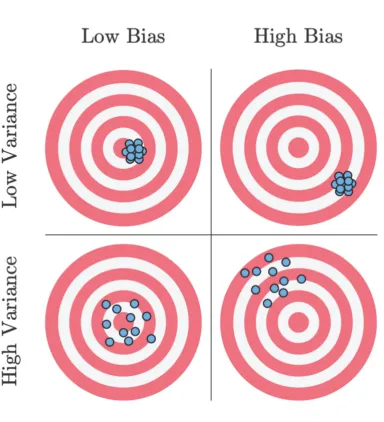Properties of estimators
Announcements
HW 03 due TODAY at 11:59pm
Project exploratory data analysis due TODAY at 11:59pm
- Next project milestone: Presentations in March 28 lab
Statistics experience due April 22
Questions from this week’s content?
Topics
- Properties of the least squares estimator
This is not a mathematical statistics class. There are semester-long courses that will go into these topics in much more detail; we will barely scratch the surface in this course.
Our goals are to understand
Estimators have properties
A few properties of the least squares estimator and why they are useful
Properties of
Motivation
We have discussed how to use least squares and maximum likelihood estimation to find estimators for
How do we know whether our least squares estimator (and MLE) is a “good” estimator?
When we consider what makes an estimator “good”, we’ll look at three criteria:
- Bias
- Variance
- Mean squared error
Bias and variance
Suppose you are throwing darts at a target
. . .

Unbiased: Darts distributed around the target
Biased: Darts systematically away from the target
Variance: Darts could be widely spread (high variance) or generally clustered together (low variance)
Bias and variance
Ideal scenario: Darts are clustered around the target (unbiased and low variance)
Worst case scenario: Darts are widely spread out and systematically far from the target (high bias and high variance)
Acceptable scenario: There’s some trade-off between the bias and variance. For example, it may be acceptable for the darts to be clustered around a point that is close to the target (low bias and low variance)
Bias and variance
Each time we take a sample of size
Suppose we take many independent samples of size
The estimators are centered at the true parameter (unbiased)
The estimators are clustered around the true parameter (unbiased with low variance)
Properties of
Finite sample (
Unbiased estimator
Best Linear Unbiased Estimator (BLUE)
Asymptotic (
Consistent estimator
Efficient estimator
Asymptotic normality
Finite sample properties
Unbiased estimator
The bias of an estimator is the difference between the estimator’s expected value and the true value of the parameter
Let
An estimator is unbiased if the bias is 0 and thus
Expected value of
Let’s take a look at the expected value of least-squares estimator:
Expected value of
The least squares estimator (and MLE)
Variance of
. . .
We will show that
Gauss-Markov Theorem Proof
Suppose
Let
What is the dimension of
Gauss-Markov Theorem Proof
We need to show
Gauss-Markov Theorem Proof
What assumption(s) of the Gauss-Markov Theorem did we use?
What must be true for
Gauss-Markov Theorem Proof
Now we need to find
Gauss-Markov Theorem Proof
What assumption(s) of the Gauss-Markov Theorem did we use?
Gauss-Markov Theorem Proof
We have
. . .
We know that
. . .
When is
. . .
Therefore, we have shown that
Properties of
Finite sample (
Unbiased estimator ✅
Best Linear Unbiased Estimator (BLUE) ✅
Asymptotic (
Consistent estimator
Efficient estimator
Asymptotic normality
Asymptotic properties
Properties from the MLE
Recall that the least-squares estimator
Maximum likelihood estimators have nice statistical properties and the
- Consistency
- Efficiency
- Asymptotic normality
We will define the properties here, and you will explore them in much more depth in STA 332: Statistical Inference
Mean squared error
The mean squared error (MSE) is the squared difference between the estimator and parameter.
. . .
Let
. . .
Mean squared error
. . .
The least-squares estimator
Consistency
An estimator
. . .
This means that as the sample size goes to
Why is this a useful property of an estimator?
Consistency
Consistency of
. . .
Now we need to show that
What is
Show
. . .
Therefore
Efficiency
An estimator if efficient if it has the smallest variance among a class of estimators as
By the Gauss-Markov Theorem, we have shown that the least-squares estimator
Maximum Likelihood Estimators are the most efficient among all unbiased estimators.
Therefore,
Proof of this in a later statistics class.
Asymptotic normality
Maximum Likelihood Estimators are asymptotically normal, meaning the distribution of an MLE is normal as
Therefore, we know the distribution of
Proof of this in a later statistics class.
Recap
Finite sample (
Unbiased estimator ✅
Best Linear Unbiased Estimator (BLUE) ✅
Asymptotic (
Consistent estimator ✅
Efficient estimator ✅
Asymptotic normality ✅
